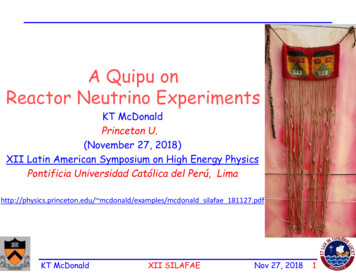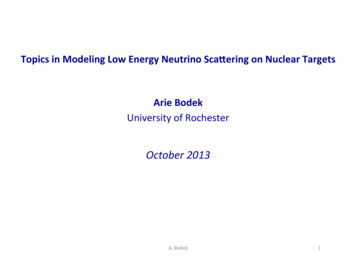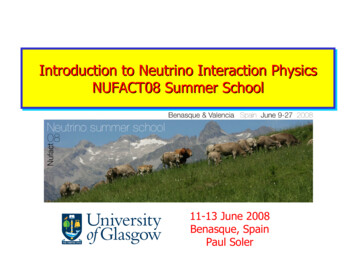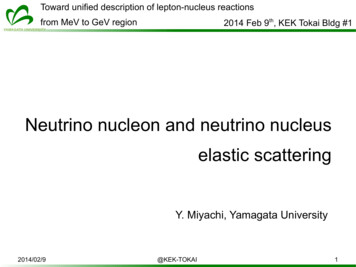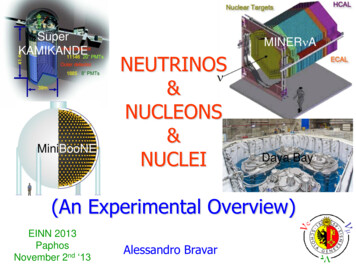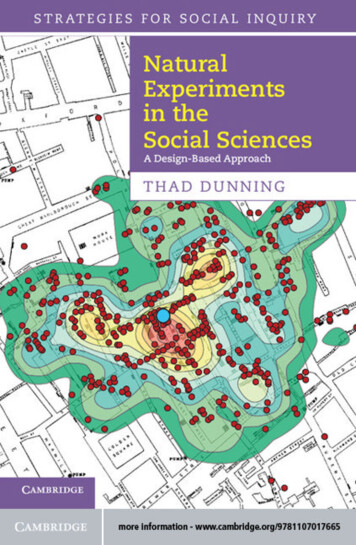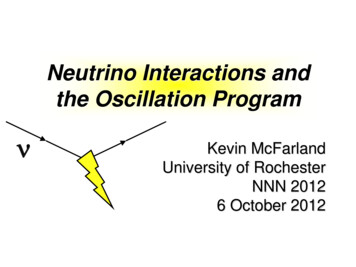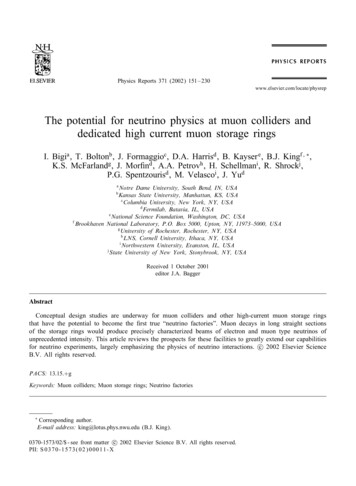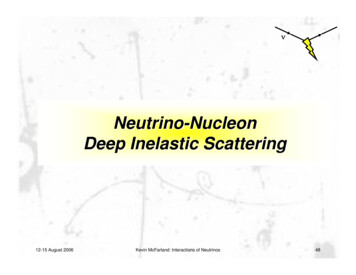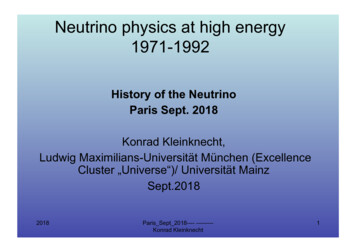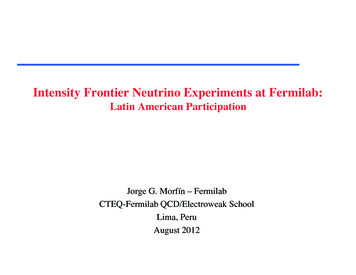
Transcription
Intensity Frontier Neutrino Experiments at Fermilab: Latin American Participation Jorge G. Morfín – FermilabCTEQ-Fermilab QCD/Electroweak SchoolLima, PeruAugust 2012
The Scene at FermilabGoals of this presentation:1) Flavor of present/future Intensity Frontier experiments at FNAL2) Outline a model for Latin American collaboration with FNALIntensity Frontier experiments2
Frontiers at Fermilab3
International Collaborations Experimental Programs at Fermilab27 countries24 countries17 countries4Young-Kee Kim, ICFA Seminar, CERN, October 3, 20114
Intensity Frontier Experiments International Collaboration17 countries5
Intensity Frontier: FNAL Present and Future Vision Phased approach with ever-increasing beam intensities and detector capabilities. Intensity Frontier – with accelerator turn-on in Spring 2013 FNAL actively pursuing a program of neutrino physics with MINOS ,(MiniBooNE), MINERνA and NOνAAdd LAr TPC MicroBooNE later in the year/early 2014Intensity Frontier – Future Vision The P5 panel recommends an R&D program in the immediate future to designa multi-megawatt proton source at Fermilab and a neutrino beamline toDUSEL . R&D on the technologies for a large multi-purpose neutrino andproton decay detector. This became the LBNE Experiment.A neutrino program with a multi-megawatt proton source (Project X)would be a stepping stone toward a future neutrino source, such as a neutrinofactory based on a muon storage ring . This in turn could position the USprogram to develop a muon collider as a long-term means to return to theenergy frontier in the US.6
Energy and Intensity Frontier Strategy - AcceleratorsTo build upon our existing strengths to establish a world-leadingprogram at the Intensity Frontier, enabled by a world-class facilityNuMINuMI(120 GeV):(120GeV):350 kW700 kWBoosterBooster(8GeV): 35 kW(8GeV): 80 kWProject-X: 2MW @ 120 GeV3MW @ 3 GeV150 kW @ 8 GeVNeutrinoFactory and use this program to provide a cornerstonefor an Energy Frontier facility beyond LHCLHCTevatronLHC Upgrades inluminosity and energyLeptonCollidersTechnology Development and Fundamental Accelerator Science while relying on a strong program of technologydevelopment and fundamental accelerator science.7
Intensity Frontier Strategy - 2e2016Project X(LBNE, µ2e, K,nuclear, )ν Factory2020’s8
The “Driver” in Designing a Neutrino ExperimentFirst Calculation of Neutrino Cross Sections using the “Fermi” theory from 1932Bethe-Peierls (1934): calculation of first cross-section for inversebeta reaction using Fermi’s theory for:oryields:This means that the mean free path of a neutrino in water is:Experimentalists groaned - need a very intensesource of ν‘s to detect neutrino interactionsAt 20 GeV,σ/Εν 0.6 x 10-38 cm29
In the Low-energy (LE) configurationdelivers 35x1012 protons on target(POT) per spill at 0.5 Hz, a beampower of 300-350 kW.120 GeV proton Carbon targetpC π and K Magnetic horns focus or -π / K µ νµ or π- / K- µ- νµmovableMINERvA10
University of AthensOtterbein UniversityUniversity of Texas at AustinPontificia Universidad Catolica del PeruCentro Brasileiro de Pesquisas FísicasUniversity of PittsburghFermilabUniversity of RochesterUniversity of FloridaRutgers UniversityUniversité de GenèveTufts UniversityUniversidad de GuanajuatoUniversity of California at IrvineHampton UniversityUniversity of Minnesota at DuluthInst. Nucl. Reas. MoscowUniversidad Nacional de IngenieríaMass. Col. Lib. ArtsUniversidad Técnica Federico Santa MaríaNorthwestern UniversityWilliam and Mary11
The MINERνA CollaborationFIVE Latin American Groups G. TzanakosUniversity of Athens, Athens, GreeceD.A.M. Caicedo, C. Castromonte, G.A. Fiorentini, H. da Motta, J.L. PalominoCentro Brasileiro de Pesquisas Físicas, Rio de Janeiro, BrazilC. Simon, B. ZiemerUniversity of California, Irvine, CaliforniaL. Bagby, D. Boehnlein, R. DeMaat, D.A. Harris*, J. Kilmer, J.G. Morfin, J. Osta, A.Pla-Dalmau, P. Rubinov, D. Schmitz, R. StefanskiFermi National Accelerator Laboratory, Batavia, IllinoisN. TaggOtterbein College, Westerville, OhioA. M. Gago, N. Ochoa, C. E. Perez, J. P. VelasquezPontificia Universidad Catolica del Peru, Lima, PeruS. Boyd, S. Dytman, I. Danko, B. Eberly, Z. Isvan, D. Naples, V. PaoloneUniversity of Pittsburgh, Pittsburgh, PennsylvaniaJ. Grange, J. Mousseau, R. Napora, B. Osmanov, H. RayUniversity of Florida, Gainesville, FloridaA. Bodek, R. Bradford, H. Budd, J. Chvojka, M. Day, R. Flight, H. Lee, S.Manly, K.S. McFarland*, A. McGowan, A. Mislivec, J. Park, G. Perdue, J.WolcottUniversity of Rochester, Rochester, New YorkJ. Felix, A. Higuera, Z. Urrutia, G. ZavalaUniversidad de Guanajuato, Leon Guanajuato, MexicoG. Kumbartzki, T. Le, R. Ransome#, B. TiceRutgers University, New Brunswick, New JerseyM.E. Christy#, R. Ent, C.E. Keppel, P. Monaghan, T. Walton, L. ZhuHampton University, Hampton, VirginiaM. Jerkins, S. Kopp, L. Loiacono, R. Stevens IVUniversity of Texas, Austin, TexasA. Butkevich, S. KulaginInstitute for Nuclear Research, Moscow, RussiaH. Gallagher, T. Kafka, W.A. Mann#, W. OliverTufts University, Medford, MassachusettsI. Niculescu, G. NiculescuJames Madison University, Harrisonburg, VirginiaM. Alania, C.J. Solano SalinasUniversidad Nacional de Ingenieria, Lima, PeruE. MaherMassachusetts College of Liberal Arts, North Adams, MassachusettsW. Brooks, E. Carquina, G. Maggi, C. Peña, I. Potashnikova, F. ProkoshinUniversidad Técnica Federico Santa María, Valparaíso, ChileR. Gran, M. LanariUniversity of Minnesota-Duluth, Duluth, MinnesotaL. Aliaga, J. Devan, M. Kordosky, J.K. Nelson, J. Walding, D. ZhangThe College of William and Mary, Williamsburg, VirginiaL. Fields, H. SchellmanNorthwestern University, Evanston, Illinois* Co-Spokespersons# Members of the MINERvA Executive Committee12
A Basic Neutrino Detector – Heavy Massive Target! Have to understand how neutrinos interact in a nucleus! The MINERvA detector offers high resolution using simple,well-understood technology and a (mainly) C targetDS HCAL:Active core (8.3 t) is segmented solid scintillator30 tons Core surrounded by electromagnetic and hadronic calorimeters Side HCAL:116 tonsTracking (including low p protons)Particle identification3 ns (RMS) per hit timing (track direction, stopped K )Photon (π0) & hadron energymeasurementνDS ECAL:15 tonsNuclear Targets: LHe, C, Fe, Pb (0.2, 0.15, 0.7, 0.85 t)MINOS Near Detector as muon catcher13
120 scintillator modules for tracking and calorimetry ( 32k readout channels).Cryogenic He and Water targets recently added. MINOS Near Detector serves as muon spectrometer. 14
AnotherModuleXVOneModule17mm16.7mmCharge sharing forimproved positionresolution and alignmentXUScintillator - TrackingLead - EM calorimetrySteel - hadronic calorimetryσ 2.6 mm15
What does a Neutrino Event “look” like? Good for identifying electronsνµ Fe µ- p“Quasi-elastic”νµ C µ- (p π0)Δ 16
MINERνA ν Scattering Physics Program In red currently studied *Quasi-elastic*Resonance Production - 1piTransition Region – n pi to DIS*Coherent Pion Production Strange & Charm Particle Production * σT – Inclusive/DIS* Latin American Participation *Nuclear Effects (He, C, H2O, Fe, Pb)Generalized Parton Distributions *Test Beam Effort High-x parton distribution functionsStructure Functions and PDFs17
MINERνA Expected Results σQE and high Q2 axial form factor of nucleon Coherent cross-sections vs. energy (An example simulated analysis using the NEUGEN event generator)σ vs Eνσ vs A18
Neutrino Nuclear Effects – results depend on A Nuclear Parton Distribution Functions - nPDFUsing charged lepton and1.2EMCNMCE139E6651.11Using neutrinosFermi motion0.90.8shadowing0.70.001EMC effect0.01xsea quark10.1valence quarkAlready CTEQ/Grenoble/Karlsrühe analysis showing nuclear effects in ν - Fe(NuTeV data) quite different than those in µ/e – FePDFs in a nucleon bound in a nucleus are DIFFERENT thanPDFs in a free nucleon19
Beam-on (2013): The MINOS Experiment Collaborators from Brazil, would welcome othersFAR DETECTOR – 5.4 ktNEAR DETECTOR – 1 ktVeto ShieldCoil Search for non-standard 3x3 mixing behaviorθ23 and Δm2atm (the new precision frontier)Search for Sterile NeutrinosNon-Standard Interactions & Extra DimensionsAtmospherics20
NuMI Facility / MINOS Experiment at Fermilab Precision measurements of: Energy distribution of oscillationsMeasurement of oscillation parameters Participation of neutrino flavors NuMI: Neutrinos at Main Injector120 GeV protons1.9 second cycle timeSingle turn extraction (10µs)Direct measurement of ν vs ν oscillation Magnetized far detector: atm. ν’s.Near Detector: 980 tonsFar Detector: 5400tonsDet.2Det.121
The MINOS Far Detector 8m octagonal steel &scintillator trackingcalorimeterSampling every 2.54 cm 4cm wide strips ofscintillator 2 sections, 15m each 5.4 kton total mass 55%/ E for hadrons 23%/ E for electronsMagnetized Iron (B 1.5T)484 planes of scintillator 26,000 m2 22
2-Flavor Oscillation - νµ Disappearance As an example, if there are only two flavors involved in the oscillations thenthe U matrix takes on the following form and the probability (square of theamplitude) can be expressed as:iδ cosθesinθ andU -i δ e sin θcosθ L(km) 22P(ν l ν l ' ) sin 2θ sin 1.27Δm (eV )E(GeV) 22with Δm 2 M22 - M21Life is more complicated with 3 flavors, but the principle is the same and wegetbonus of possible CP violations as in the quark sector P(νµ -- νe) P(νµ-- νe). The components of U now involve θ13 , θ23 ,θ12 and δ and the probabilitiesinvolveΔm13 , Δm23 and Δm12 . 23
MINOS Best-Fit 7.2 x 1020 POT Observe 1986 νµ events in FD expect 2451 with no oscillations Δm2 2.35x 10-3 eV2 (68% CL), sin2(2θ) 0.91 (90% CL)24
How to interpret oscillation results25
MINOS : Sterile Neutrinos Powerful search for sterile neutrinos Odd dip will have to wait for MINOS for more study Oscillation spectrum pretty insensitive to primary oscillationparameters in this region26
Beam-on 2013 NuMI to NOνA27
Going into NOνA, what have we learned? From observing neutrinos from the sun and reactors,we have learned that νe νµ and νe ντ with L / E 15 000 km/GeV, with a large but not maximal mixingangle, θ12. From observing neutrinos produced in the atmosphereby cosmic rays and 1st generation acceleratorexperiments (K2K and MINOS) we have learned thatνµ ντ with L / E 500 km/GeV, with a mixingangle, θ23, consistent with being maximal28
Going into NOνA, what have we learned?Know to someextentDon’t knowO. Mena and S. Parke, hep-ph/031213129
How important is determining the mass ordering? Window on very high energy scales: grand unified theories favorthe normal mass ordering, but other approaches favor the invertedordering. If we establish the inverted ordering, then the next generation ofneutrinoless double beta decay experiment can decide whether theneutrino is its own antiparticle. However, if the normal orderingis established, a negative result from these experiments will beinconclusive. To measure CP violation, we need to resolve the mass ordering,since it contributes an apparent CP violation for which we mustcorrect.30
The NOvA Experiment - νe appearance Would Welcome Latin American Collaborators NOvA is an approved Fermilab νµ νe appearance experimentcurrently finishing construction expecting to start Spring 2013 Unique long baseline Near and Far detectors with a 810 km baselineLocated Off the Beam Axis for Background SuppressionUse matter effects to determine the neutrino mass hierarchyNear and Far Detectors optimized for νe charged-current detectionPrimary Physics Goals Confirm θ13Determine Mass HierarchyInitial lookat a CP Violation Measurement.31
To 1 APD pixelNOvA Far Detector “Totally Active” scintillator detectorLiquid scintillator cells3.9 cm x 6 cm x 15.7m 0.15 X0 sampling 1654 planes of cells Cell walls Extruded rigid PVC Readout 15.7 m U-shaped 0.8 mm WLS fiberAPDs 85% QE cooled to -15 C14 kT of total mass 15.7m x 15.7m x 67 m6 cm32-cell APD32
FermilabGothicat OrrReceptionGary FeldmanSLAC SeminarReception at Orr23 June 200933Jim’s Ash Trail Store33
NEXT STEP - Fermilab to DUSEL: LBNE Project Would welcome Latin American Collaborators1300 km34
NOvA735 km810 kmLBNE Collaboration:mineiron700kWat Soudan306 members from58 institutions from India,Italy, Japan, UK, US15kt LiquidMINOSContinues to grow!(Far Det.)ScintillatorLBNE(Long Baseline Neutrino Experiment)1300 km Liquid Ar TPCICARUSArgoNeuTMicroBooNEMINERvAMicroBooNEMatter – Antimatter Asymmetry with NeutrinosProton DecaySupernovae Neutrinos35
LBNE Physics Goals Search for, and precision measurements of, the parameters thatgovern νµ νe oscillations. measurement of the CP violating phase δ anddetermining of the mass ordering (sign of Δm232).Precision measurements of θ23 and Δm232 in the νµ disappearancechannel.Search for proton decay, yielding a significant improvement incurrent limits on the partial lifetime of the proton (τ/BR) in one ormore important candidate decay modes, e.g. p e π or p K ν.Detection and measurement of the neutrino flux from a corecollapse supernova within our galaxy, should one occur during thelifetime of LBNE.36
LBNE Near Detector Considerations37
Far Detectors to be placed in DUSEL Facility LAr TPC: Designing 17 kT fiducial volume modules ( 100 kTWC Equivalent) for oscillation physics.To be placed closer to the surface (800 foot level)38
LBNE uses wideband neutrino beamDo we need the capability to study both the 1st and 2nd oscillation maxima in a (wideband) long baseline experiment in order to break inherent degeneracies between CPvand matter effectsννBackgrounds from NC π0 production feed downStudy above assumes 5% knowledge of backgroundBasic cross-sections have large uncertainties (30-100%)39
NuMI(NOvA)8 GeV ILC-like Linac40
41
Project X Research Program Would welcome Latin American Collaborators Long baseline neutrino oscillation experiments:Driven by a high-power proton source with proton energies between 50 and 120 GeV thatwould produce intense neutrino beams directed toward massive detectors at a distant deepunderground laboratory. Kaon, muon, nuclei & neutron precision experiments driven byhigh intensity proton beams running simultaneously with theneutrino program:These could include world leading experiments searching for muon-to-electron conversion,nuclear and neutron electron dipole moments (edms), and world-leading precisionmeasurements of ultra-rare kaon decays. Platform for evolution to a Neutrino Factory and Muon Collider42
The Neutrino Factory(High intensity circulating muons)Active collaboration would welcome Latin American collaborators4343
Muon decay followed by oscillation µ- e- νe νµ For circulating µ- decays, look for νeoscillating to νµ that, wheninteracting in your detector, yields aµ !! No need for a fancy electronsensitive detector. Magnetized irondetector will do Best configuration with large θ13 One100 kt detector at 2000 kmEµ circulating at 10 GeV44
LATIN AMERICANCOLLABORATION AT INTENSITY FRONTIER EXPERIMENTS45
The MINERνA Model: Latin American collaboration at FNAL Students studying for their Masters Degree 9 studentsVisiting Scientist Invitation and Scholar VisaMulti-year residency at Fermilab working on experimentAs long as funding permits: Fermilab covers housing costsPost Doctoral Associates Visiting Scientist InvitationJ-1 visa Trainee Program: On-site Mentor1-year residency at Fermilab working on experimentAs long as funding permits: Fermilab covers housing costs and adds to perDiemStudents studying for their Doctorate 22 students1 so farVisiting Scientist and scholar visaMulti-year residency at Fermilab working on experimentAs long as funding permits: Fermilab covers housing costsProfessors Multiple 2-4 week visits and one 1-year Sabbatical27 visits 1 Sabbatical46As long as funding permits: Fermilab covers housing costs
Conclusions Fermilab offers a wide-ranging near-and-further futureexperimental approach to studying the nature of the neutrinoand how it interacts with matter via MINERνA, MINOS ,NOνA, MicroBooNE, (nuSTORM) LBNE and a neutrinofactory.Near-and-further future experiments are still welcoming newgroups.Already a strong Latin American – Brazil, Chile, Mexico andPeru – presence in MINERνA.All experiments would welcome (additional) collaborators fromLatin AmericaThere is at least one working model of how Latin Americanphysicists can collaborate at Fermilab in the Intensity Frontier.47
Intensity Frontier Accelerators (now)SCRF Test FacilityMINERvA(Integrated program for Project X and ILC)TestbeamMINOS at 735kmSeaQuestMiniBooNE8 GeV350 kW@120 GeV48
Intensity Frontier Acceleratorsfrom Spring 2013NOvA15kt LiquidScintillator810 kmNeutrinossince 2013:NOvA, MINERvAEMicroBooNMicroBooNEAr TPCL8 GeVMINOS 735 kmSCRF Test Facility with bright beams(Project X, ILC, Accelerator Science)TestbeamMINERvASeaQuest700 kW@120 GeVMiniBooNENOvA49
NOνA strategy to measure mass ordering If the CP-violating term goes in the same direction as the mattereffect, then there is no ambiguity and NOνA can determine themass ordering by itself, given sufficient integrated beam. If the CP-violating term goes in the opposite direction as the mattereffect, then there is an inherent ambiguity and NOνA cannotdetermine the mass ordering by itself. But it can be determined, inprinciple, by comparing NOνA and T2K. If the neutrino oscillation probability is larger in NOνA than in T2K, it is thenormal mass ordering; if the opposite, it is the inverted mass ordering.50
LAr TPC TechniqueWire tion PlanetimeWire #Collection PlanetimeWire #EWire pulses in time give the driftcoordinate of the trackScintillation light can give t0ICARUS 50L in WANF neutrino beam51induction plane collection plane time 3D image of event (w/ calorimetric info)
Why Off-Axis? Both Phase 2 experiments, NOνA and T2K are sited off the neutrino beamaxis. This yields a narrow band beam: More flux and less background (νe’s from K decay and higher-energyNC events)Eν 0.43 γ m π1 γ 2θ 2 52
Making an Antineutrino Beam53
MicroBooNE: Excellent e/γ separation LAr TPC images events and collects charge - do e/γ separation viadE/dx.Look at MIP deposition in first 2.4 cm of track before shower starts GEANT4 MC: 90% electron efficiency with 6.5% gamma background e/γ separation removes single γ backgrounds Electron Neutrino efficiency 2x better than MiniBooNESensitivity down to 10’s of MeV compared to MiniBoNE 200 MeV54
Details – details . Freeday: ½ day tour to Pachacamac – Inca ruins justoutside of Lima by bus, How many are interested inthis tour? Nightcap – rough idea of what you want to drink, beer,wine, Pico sours Meals at the hotel – many not there last night, wouldyou prefer to eat away from hotel, let us know. Pleasebe back for the nightcap.55
NOvA Near Detector 209 T of which 126 T totally active with 23 T fiducialThe NOvA Near Detector, nowrunning on the surface, will beplaced off-axis in the MINOS /MINERvA access tunnel.14.4 m4.1 mMuon catcher1 m ironShower containmentregion2.9 mTarget regionVeto region56
Next year: MicroBooNE A Closer look at the MiniBooNE Low-E Excess and ν vs ν Would welcome Latin American Collaborators Regardless of interpretation, excess must be understoodfor νe appearance measurementsIf ν excess in oscillation region persists, study neededFor example the T2K experiment - excess would be abackground of 100 events at E 100 MeV!ENTER Liquid Argon TPC detectors fordetailed study of neutrino interactions (andoscillations) – currently under constuction Passing charged particles ionize Argon - 55,000electrons/cm.Drift ionization electrons over meters of pure LAr tocollection planes to image the track.Extensive experience from the European ICARUSeffort.57
MicroBooNE Liquid Argon TPC 70 ton fiducial L Ar TPC detectorLocated in the Booster neutrino beamCollect 6x1020 POT from on-axis Booster Neutrino BeamCollect 8x1020 POT from off-axis LE NuMI BeamIn addition to interesting physics motivation, this is an important step alongthe way to making LAr TPC a practical detection method for small andLARGE detectors58
ArgoNeuTMicroBooNELAr5Mass hierarchy,q1359DUSEL LArCP-violation, proton decay
4x1012 8 GeV protons hit a Be targetat up to 4 Hz.Pions focused with a 174 kA pulsedmagnetic horn.Use HARP hadron production data topredict flux via Geant 4 MC ofbeamline components.60
A neutrino program with a multi-megawatt proton source (Project X) would be a stepping stone toward a future neutrino source, such as a neutrino . shadowing" EMC effect" Fermi motion" sea quark" x ! vale
